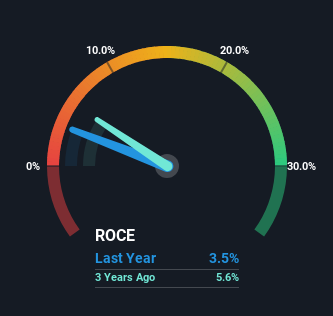- Hong Kong
- /
- Renewable Energy
- /
- SEHK:686
Here's What's Concerning About Beijing Energy International Holding's (HKG:686) Returns On Capital
If we want to find a stock that could multiply over the long term, what are the underlying trends we should look for? Typically, we'll want to notice a trend of growing return on capital employed (ROCE) and alongside that, an expanding base of capital employed. Basically this means that a company has profitable initiatives that it can continue to reinvest in, which is a trait of a compounding machine. Having said that, from a first glance at Beijing Energy International Holding (HKG:686) we aren't jumping out of our chairs at how returns are trending, but let's have a deeper look.
Return On Capital Employed (ROCE): What Is It?
Just to clarify if you're unsure, ROCE is a metric for evaluating how much pre-tax income (in percentage terms) a company earns on the capital invested in its business. Analysts use this formula to calculate it for Beijing Energy International Holding:
Return on Capital Employed = Earnings Before Interest and Tax (EBIT) ÷ (Total Assets - Current Liabilities)
0.035 = CN¥2.5b ÷ (CN¥102b - CN¥32b) (Based on the trailing twelve months to June 2024).
Thus, Beijing Energy International Holding has an ROCE of 3.5%. In absolute terms, that's a low return and it also under-performs the Renewable Energy industry average of 6.9%.
See our latest analysis for Beijing Energy International Holding

Historical performance is a great place to start when researching a stock so above you can see the gauge for Beijing Energy International Holding's ROCE against it's prior returns. If you want to delve into the historical earnings , check out these free graphs detailing revenue and cash flow performance of Beijing Energy International Holding.
So How Is Beijing Energy International Holding's ROCE Trending?
When we looked at the ROCE trend at Beijing Energy International Holding, we didn't gain much confidence. To be more specific, ROCE has fallen from 5.9% over the last five years. However, given capital employed and revenue have both increased it appears that the business is currently pursuing growth, at the consequence of short term returns. And if the increased capital generates additional returns, the business, and thus shareholders, will benefit in the long run.
The Bottom Line On Beijing Energy International Holding's ROCE
Even though returns on capital have fallen in the short term, we find it promising that revenue and capital employed have both increased for Beijing Energy International Holding. These growth trends haven't led to growth returns though, since the stock has fallen 38% over the last five years. So we think it'd be worthwhile to look further into this stock given the trends look encouraging.
If you'd like to know about the risks facing Beijing Energy International Holding, we've discovered 1 warning sign that you should be aware of.
While Beijing Energy International Holding isn't earning the highest return, check out this free list of companies that are earning high returns on equity with solid balance sheets.
Valuation is complex, but we're here to simplify it.
Discover if Beijing Energy International Holding might be undervalued or overvalued with our detailed analysis, featuring fair value estimates, potential risks, dividends, insider trades, and its financial condition.
Access Free AnalysisHave feedback on this article? Concerned about the content? Get in touch with us directly. Alternatively, email editorial-team (at) simplywallst.com.
This article by Simply Wall St is general in nature. We provide commentary based on historical data and analyst forecasts only using an unbiased methodology and our articles are not intended to be financial advice. It does not constitute a recommendation to buy or sell any stock, and does not take account of your objectives, or your financial situation. We aim to bring you long-term focused analysis driven by fundamental data. Note that our analysis may not factor in the latest price-sensitive company announcements or qualitative material. Simply Wall St has no position in any stocks mentioned.
About SEHK:686
Beijing Energy International Holding
An investment holding company, engages in the investment, development, operation, and management of power plants and other clean energy projects in the People’s Republic of China, Australia, and Vietnam.
Acceptable track record second-rate dividend payer.
Market Insights
Community Narratives


Recently Updated Narratives


MINISO's fair value is projected at 26.69 with an anticipated PE ratio shift of 20x


The Quiet Giant That Became AI’s Power Grid


Nova Ljubljanska Banka d.d will expect a 11.2% revenue boost driving future growth
Popular Narratives


The company that turned a verb into a global necessity and basically runs the modern internet, digital ads, smartphones, maps, and AI.


MicroVision will explode future revenue by 380.37% with a vision towards success



